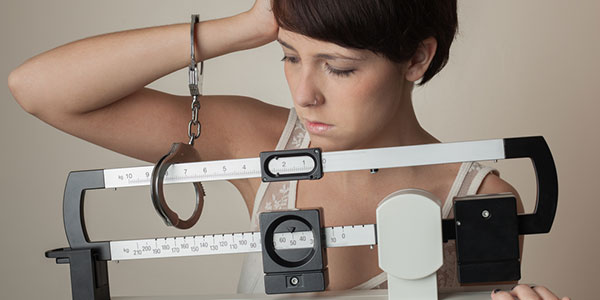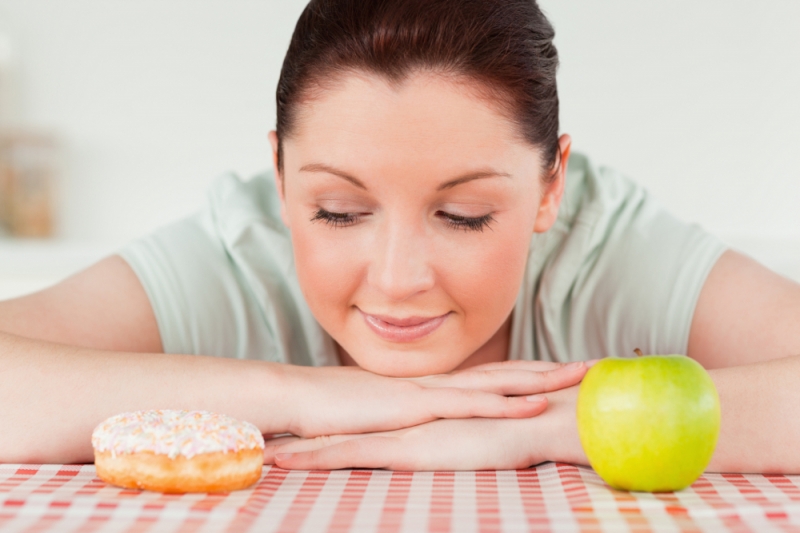Breaking Your Sugar Addiction
 That white, powdery substance just makes you feel good. You can't get it off your mind, and you keep coming back for more. The more you have it, the more you want it! But even when you try to stay away from it, it finds ways to sneak into your life almost daily. What can you do?
That white, powdery substance just makes you feel good. You can't get it off your mind, and you keep coming back for more. The more you have it, the more you want it! But even when you try to stay away from it, it finds ways to sneak into your life almost daily. What can you do?We're not talking about some dangerous or illegal drug here; we're talking about sugar. Although it's considered harmless in comparison, sugar, in excess, can cause a host of problems for a lot of us: cravings, binge eating, weight gain and heart disease among them. According to the USDA, the average American consumed 151 pounds of sugar in 1999—an all time high. Since then, consumption has dropped slightly and in 2010 the average American consumed 132 pounds. (To put that into perspective, consider that the number was just 4 pounds in the year 1700.) At least half of the sugar we consume comes from soft drinks, fruit drinks, and sports drinks. The rest sneaks into our diets in the form of ketchup, teriyaki sauce, chocolate milk and the obvious sweets like cookies, cakes, ice cream and even breakfast cereal. Surprisingly, some "healthy foods" such as yogurt and instant flavored oatmeal can pack in 20-30 grams (5-7 teaspoons) of unnecessary added sugar! It seems like we're drowning in sugar, and nobody is wearing a life vest.
The American Heart Association (AHA) recommends that we limit our daily sugar consumption to 7% or less of our daily calorie intake—that's about 6 teaspoons (100 calories) for women and 9 teaspoons (150 calories) for men. But that adds up fast. Just one 12-ounce can of regular soda contains 8-10 teaspoons of sugar and 130-150 calories. One glazed donut contains 6 teaspoons, and a half cup ice cream (the standard serving size, although most portions are much, much larger) contains 4 grams of added sugar!
Why Should You Care? Is Sugar Actually Bad for You?
Well, aside from the increased bulge around the waistline, diets high in sugar are strongly linked to an increased risk for type 2 diabetes, elevated triglycerides, low HDL (good) cholesterol levels, and heart disease. Sugar intake has also been linked to depression, migraines, poor eyesight, autoimmune diseases (such as arthritis, and multiple sclerosis), gout and osteoporosis.Recent research has shown that a high intake of carbohydrates, including sugar, releases a feel good chemical in the brain called serotonin. Think of how you feel after indulging in a high sugar meal or treat—almost euphoric, right? The high of a sugar rush is temporary though. After a few hours—or even a few minutes—you start to crash and you become tired, fatigued and lethargic.
Although sweet foods are tempting and delicious to most people (blame Mother Nature for that!), the more sugar you eat, the higher your tolerance becomes. So if you have a strong sweet tooth or intense cravings for sugar, chances are not that you were born that way, but that your dietary habits and food choices created the sugar monster you may have become.
Fortunately, we can reverse this tolerance in just a couple of weeks by cutting out sugar. Once you have decreased your threshold, something that tasted perfectly sweet a few weeks ago, will begin to taste too sweet to eat, and that can help you reduce your intake of the sweet stuff.
Cutting Out Sugar: A 4-Week Action Plan
While the occasional sweet treat won't make or break your weight loss or your health, many people have trouble stopping after a sensible portion or saying no to sugar when it's available. If you feel out of control around sugar, then a sugar "detox" is a great way to reduce your cravings, eat better, and bring sugar back to where it belongs: as an occasional treat that you consciously choose to eat in a mindful manner, not a daily treat occurrence that controls you.Follow this month-long plan to break your sugar addiction!
Week 1: Identify Sugar and Where It's Hiding
The first step in conquering your sugar habit is to rid your pantry and refrigerator of added sugar. Some things (think ice cream, cookies and candy) are obvious, but most of us need to look closer at where the sugar in our diets is coming from. This will require a bit of label reading in the beginning, but after a while, it will become easier.
In order to cut back on hidden or added sugar, scan the ingredients list of a food label. If you see any of the following terms listed, then sugar has been added to the product in one form or another and it is best left on the shelf at the store—especially if that sugar shows up within the first five ingredients of any food product.
Agave nectar
Agave syrup
Barley malt
Beet sugar
Brown rice syrup
Brown sugar
Buttered syrup
Cane sugar
Cane juice
Cane juice crystals
Carob syrup
Confectioner’s sugar
Corn syrup
High fructose corn syrup
Corn sugar
Corn sweetener
Corn syrup solids
Crystalized fructose
Date sugar
Dextran
Dextrose
Diatase
Diastatic malt
Evaporated cane juice
Fructose
Fruit juice
Fruit juice concentrate
Glucose
Glucose solids
Golden sugar
Golden syrup
Grape sugar
Grape juice concentrate
Honey
Invert sugar
Lactose
Malt
Maltodextrain
Maltose
Maple syrup
Molasses
Raw sugar
Refiner's syrup
Sorghum syrup
Sucanat
Sucrose
Sugar
Turbinado sugar
Yellow sugar
This first week is about awareness. Reading labels before you buy—or bite. How many of your favorite foods contain hidden sugars in the top of their ingredients lists?
Once you have identified the sources of sugar in your diet, clean out your kitchen. Throw out or donate all of the products that contain hidden or added sugars, including any juice, soda, candy, sweets and seemingly healthy snacks like granola bars, fruit and grain bars, instant flavored oatmeal and sports drinks. This may sound drastic, but stay with me!
Remember, you don’t have to throw away everything that is sweet! Natural sugar, like the kind you find in whole fruit, contains vitamins, minerals and fiber, which are lost in the processing of juice. Milk contains naturally occurring sugars, but also provides calcium, vitamin D and protein. So unlike soda, fruit juices and other processed foods, whole fruit and dairy products provide us with essential vitamins and minerals that our bodies need. Be wary of certain fruit- or milk-based products that contain added sugars though: flavored milk, many yogurts, fruits canned or jellied in added sugar or syrups, and the like. Opt for unflavored skim or 1% milk, plain yogurt or Greek yogurt, and whole pieces of fruit. Remember, we are trying to cut out the 151 pounds a year of added sugar, not the naturally occurring sugar found in whole foods.
Week 2: Stock Your Sugar-Free Kitchen
In one week, you've probably found lots of sugar in your diet. Some of it may have been obvious, like those frozen waffles or lattes from the local coffee joint. But others might not have been so clear, as sugar tends to lurk in many "diet" foods and lower-fat foods, added by manufacturers to make their low-cal offerings taste better.
Now that you know what to look for (and avoid), it's time to replace the products you tossed with sugar-free counterparts. For example, replace high-sugar cereals with a whole grain cereal that contains little to no added sugars. Sweeten it naturally with fresh berries or half of a diced banana. Instead of snacking on candy or cookies, reach for a handful of nuts or some raw veggies and hummus. Replace sweetened yogurt with Greek yogurt or plain yogurt. Look back at week one and the foods you used to eat that contained sugar. Can you find no-sugar oatmeal? A healthier snack than a sugar-sweetened smoothie (how about a whole piece of fruit)? A more filling afternoon treat than that sugary "protein bar" (such as peanut butter on whole-grain crackers)?
When choosing a refreshing beverage to quench your thirst, keep in mind that you want to eat your calories, not drink them. Choose ice cold water flavored with a squeeze of fresh lemon or an orange slice. Or flavor unsweetened iced tea with fresh mint, crushed raspberries, or a squeeze of citrus.
One tip to help you avoid added sugar at the supermarket is to shop the perimeter of the grocery store as much as possible. Think about the general layout of a grocery store: The outside is home to fresh fruits and vegetables, lean meats, dairy products, and whole grain breads and the inside aisles are stocked with cookies, chips, soda, fruit juice, cake mixes, and other processed foods. Spend most of your time on the outside and only go down the inner aisles for specific products, like whole-grain pasta.
Never shop on an empty stomach and always shop with a list. Shopping while hungry can lead you to adding all kinds of snacks and impulse buys to your cart. Meal planning can be a tricky task at first, but following a meal plan is an important part of breaking the sugar addiction. It will help to keep you on track and help prevent stopping for fast food when you don't have a game plan for dinner. Spend a little time on Sunday afternoons jotting down some meal ideas for throughout the week. Make a list of the food items you will need to make the meals you wrote down and stick to it!
Here are some additional resources that will help you stock a healthier kitchen:
Portable snacking tips and ideas
Over 100 super foods for a super you
Shopping cart essentials
Meal planning made easy
What about Sugar Substitutes? Sugar substitutes and sugar alcohols have their place and they may be beneficial in helping you to break the sugar addiction or they may not. You will have to experiment and see how they affect you and your cravings. Even though they may not add additional calories to your diet, sugar substitutes and sugar alcohols might not help you to BREAK the sugar addiction since they are adding the sweet flavor to your diet. In some people, they may even increase your sweet tooth.
Read on for more information:
All About Artificial Sweeteners
What Are Sugar Alcohols?
The Science Behind Stevia
Week 3: Stop the Sugar Cravings
Now you really start to put your plan into action. You’ve identified the sources of added sugar in your diet and replaced those foods with healthier and more wholesome alternatives. Your kitchen is now set up for success!
This week’s focus should be on making a conscious effort to avoid sugary foods. When a craving strikes, try going for a walk or simply drinking a glass of water. Take a hot bath or get lost in a good book. Typically any craving will pass if you wait it out long enough. But it's important to begin understanding the difference between true hunger and food cravings. If you are truly hungry, a handful of nuts or some raw veggies dipped in hummus will sound appetizing, so go ahead and eat one of your healthy snacks. But if you're craving something sweet or a specific sugary food, use a distraction technique.
The first week of saying no to sugar will be the hardest, but the more diligently you stick to your plan, the better you'll fare in the end. Even a tiny taste of sugar during this time period can lead to setbacks.
After a couple sugar-free weeks, your sugar threshold will start to decrease and you will find that you no longer crave sugar or sweets as you once did. As with any lifestyle change, the first couple of weeks are the hardest. Eventually, it will become habit to reach for a mint tea or piece of fruit instead of juice and candy.
Week 4: Game Plan for Life
Now that you have yanked that sweet tooth, it's time to devise a plan to prevent a sugar addiction relapse. Although sugar isn't necessary for health and it's perfectly fine if you want to continue avoiding it, it probably isn't realistic for most people to avoid all forms of sugar forever.
So if you want to allow a little sweetness back into your life, that's OK. Moderation is key. Don't let sugar and sweets become a daily habit. Instead, consider them to be special occasion treats only. With your lowered threshold for sweetness, that shouldn't be too hard. But if you begin to indulge too often or overindulge over a short period of time (such as a weeklong vacation), you could find yourself back in trouble with sugar all over again.
If you slip up, don’t beat yourself up over it. Accept your action and decide to make a better decision next time and move on. Continue to experiment with your new, healthy foods and recipes. You'd be surprised at how many ways you can make treats healthier and use far less sugar than a recipe suggests.
And remember: It generally takes about 3-4 weeks for a new behavior to become habit, the most important thing is to stick with it.
This article has been reviewed and approved by SparkPeople's nutrition expert, Becky Hand, M.S., Licensed and Registered Dietitian.
Related Articles
-
On-The-Job Weight Loss: Worksite Programs Work
Employer-sponsored programs for weight loss are at least partially eff
-
Weight Loss Helped By Mind Over Body
Copyright 2005 Mary DesaulniersTo increase the success rate of any
-
Can Breathing Help You Lose Weight
We all know that obesity is on the increase, we see it every day on TV
-
Three Tips For Finding A Healthy Weight Loss Diet
Every one of us a one time or another has put on unwanted extra pou
-
Taking Better Care of Yourself: Making Time for Self Care
New Years resolutions tend to fizzle out sometime in the first six
-
Oprah Show Series: Have You Let Yourself Go?
We can always count on Oprah. If we need a good book, or a good ch
- DON'T MISS
- Quick Weight Loss And Staying Slim
- Weight Loss Surgery In Mexico Savings
- 2 Tricks to a Morning Metabolism Boost
- Break The Chain Of Yo-Yo Dieting
- 5 Surprising Things I Learned From A Biblical Weight-Loss Program
- 3 Easy Steps To Gain Muscle Mass
- How I Got My Stubborn Parents To Change Their Unhealthy Diet
- Redefining Hunger Can Kick Start Weight Loss
- Using Hypnosis To Achieve Weight Loss
- Thermogenic Foods That Burn Belly Fat




